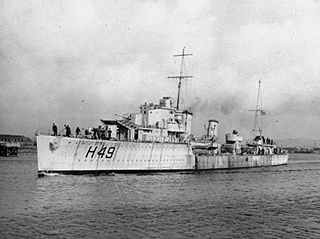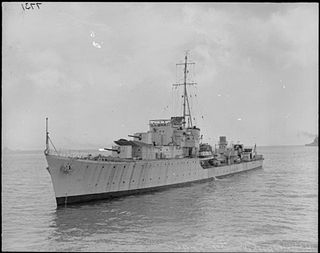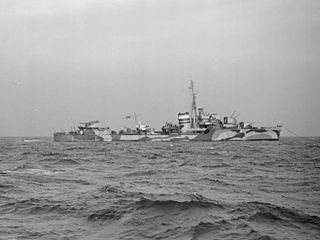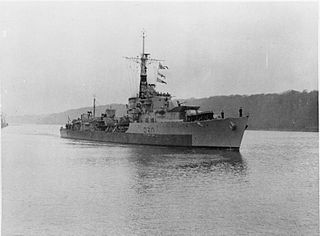
HMS Inconstant was an I-class destroyer built for the Turkish Navy, but was purchased by the Royal Navy in 1939.

The A- and B-class destroyers were a group of 18 destroyers built for the Royal Navy during the late 1920s, with two additional ships built for the Royal Canadian Navy. The British ships were divided into two flotillas of eight destroyers, each with a flotilla leader.

The O and P class was a class of destroyers of the British Royal Navy. Ordered in 1939, they were the first ships in the War Emergency Programme, also known as the 1st and 2nd Emergency Flotilla, respectively. They served as convoy escorts in World War II, and some were subsequently converted to fast second-rate anti-submarine frigates in the 1950s.

The C class was a class of 32 destroyers of the Royal Navy that were launched from 1943 to 1945. The class was built in four flotillas of 8 vessels, the "Ca", "Ch", "Co" and "Cr" groups or sub-classes, ordered as the 11th, 12th, 13th and 14th Emergency Flotillas respectively. The sub-class names are derived from the initial 2 letters of the member ships' names, although the "Ca" class were originally ordered with a heterogeneous mix of traditional destroyer names. A fifth flotilla, the "Ce" or 15th Emergency Flotilla, was planned but were cancelled in favour of the Weapon-class destroyers after only the first two ships had been ordered. The pennant numbers were all altered from "R" superior to "D" superior at the close of World War II; this involved some renumbering to avoid duplications.

The I-class destroyers were a group of nine destroyers, including a flotilla leader, built for the Royal Navy during the 1930s. Four similar ships were ordered by the Turkish Navy, of which two were purchased for the Royal Navy, bringing the number of these ships British service to 11—although three of the original ships had been lost by the time Inconstant and Ithuriel were commissioned. The I-class served in World War II and six were lost, with a seventh ship being written off.

HMS Raider was a R-class destroyer built for the Royal Navy during the Second World War.

The J, K and N class consisted of 24 destroyers built for the Royal Navy beginning in 1938. They were a return to a smaller vessel, with a heavier torpedo armament, after the Tribal class that emphasised guns over torpedoes. The ships were built in three flotillas or groups, each consisting of eight ships with names beginning with "J", "K" and "N". The flag superior of the pennant numbers changed from "F" to "G" in 1940.

The Danae or D class consisted of eight light cruisers built for the Royal Navy at the end of World War I which also saw service in World War II.

HMS Roebuck was an R-class destroyer of the British Royal Navy that saw service during World War II. She was the fifteenth ship to carry this traditional ship name, after a small deer native to the British Isles, which was used as far back as the reign of Queen Elizabeth I.

HMS Veteran was an Admiralty modified W-class destroyer built for the Royal Navy. She was ordered in April 1918 from John Brown & Company under the 14th War Program. She was the third Royal Navy ship to carry the name.

HMS Milne was a M-class destroyer of the Royal Navy which served during World War II. She was equipped as a flotilla leader.

HMS Consort was one of thirty-two C-class destroyers built for the Royal Navy during the Second World War, a member of the eight-ship Co sub-class.

HMS Loyal was a L-class destroyer built for the Royal Navy in the late 1930s, although she was not completed until after World War II had begun.

HMS Carron was one of thirty-two C-class destroyers built for the Royal Navy during the Second World War, a member of the eight-ship Ca sub-class. Commissioned in late 1944, she was assigned to the Home Fleet and escorted the fleet's larger ships during operations off German-occupied Norway. Carron was sold for scrap in 1967.

HMS Cavendish was one of eight C-class destroyers built for the Royal Navy during the Second World War. Commissioned in late 1944, she was built as a flotilla leader with additional accommodation for staff officers. The ship was assigned to the Home Fleet in 1945 after working up where she escorted capital ships of the fleet. Cavendish was sold for scrap in 1967.

HMS Cambrian was one of eight C-class destroyers built for the Royal Navy during the Second World War. commissioned in mid-1944, she was assigned to the Home Fleet and escorted two Arctic convoys as well as larger elements of the fleet during operations off the German-occupied Norwegian coast.

HMS Caesar was one of thirty-two C-class destroyers built for the Royal Navy during the Second World War, a member of the eight-ship Ca sub-class. Commissioned in 1944, she was built as a flotilla leader with additional accommodation for staff officers. The ship was assigned to Home Fleet during 1944–1945 and escorted one Arctic convoy as well as the capital ships of the fleet.

HMS Childers was one of thirty-two C-class destroyers built for the Royal Navy during the Second World War, a member of the eight-ship Ch sub-class. Commissioned in 1945, she was built as a flotilla leader with additional accommodation for staff officers.

HMS Chivalrous was one of thirty-two C-class destroyers built for the Royal Navy during the Second World War, a member of the eight-ship Ch sub-class. Commissioned in 1946, she was built as a flotilla leader with additional accommodation for staff officers. The ship was loaned to the Pakistani Navy during the late 1950s and was sold for scrap in 1961 after being returned.

HMS Comet was one of thirty-two C-class destroyers built for the Royal Navy during the Second World War, a member of the eight-ship Co sub-class.




















